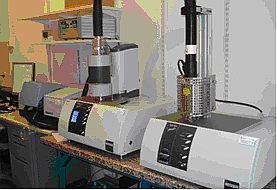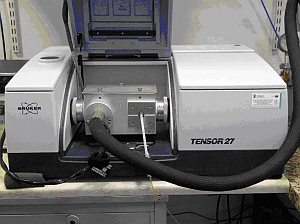The STA 449 F1 Jupiter® by NETZSCH combines unlimited configuration of (Thermogravimetry (TG) and Differential Scanning Calorimetry (DSC), flexibility and unmatched performance in just one instrument. These methods allow measuring thermal stability, decomposition behavior, material compositions, phase transitions, melting processes temperature, and mass loss of sample during temperature program. The STA 449 F1 Jupiter® device has two furnaces: SiC and Stainless steel.
EGA is a method used to study the gas evolved from a heated sample that undergoes decomposition or desorption. By coupling the thermal analysis instrument, TG-DSC, with a fast QMS or/and FTIR the detection of gas separation and identification of the separated components are possible in exact time correlation with the other thermal analysis signals.
 |
 |
 |
| STA 449 F1 Jupiter (in the middle), Quadrupole Mass Spectrometer Netzsch, model QMS 403 C Aëolos (to the right). | Fourier Transform Infrared Spectrometer, Bruker, model Tensor 27 |
Attenuated Total Reflectance, Bruker, model Platinium ATR-Einheit A 255 |
| Equipment | Temperature | Parameters | What can be measure |
| STA 449 F1 Jupiter (SiC furnace) |
RT-1500°C possible to couple with QMS and FTIR | -mass range: 5-50mg -heating rate: 0.01 to 50K/min | -decomposition -analysis of sample -evaporation -melting temperature -glass transition temperature -phase transitions -mass loss |
| STA 449 F1 Jupiter (stainless steel furnace) |
-150-800°C | -mass range: 5-50mg -heating rate: 0.01 to 50K/min | -decomposition -analysis of sample -evaporation -melting temperature -phase transitions -mass loss |
| QMS 403 C Aëolos | Increasing the temperature of the entire gas transfer system to 300°C | Mass range: 2 - 300 amu, Measuring Modes: MID and Scan | -identification of released gasses during temperature program |
| FTIR Tensor 27 | coupling with STA | 6000 cm-1 to 500 cm-1 | -identification of released gasses during temperature program -chemical composition |
| ATR | RT | 6000 cm-1 to 400 cm-1 | -chemical composition |
Simultaneous Thermal Analysis (STA) is the simultaneous application of Thermogravimetry (TG) and Differential Scanning Calorimetry (DSC) to one sample. The information gathered is enhanced by coupling the STA instrument to an Evolved Gas Analyzer (EGA): Fourier transform infrared spectroscopy (FTIR) and Quadrupole Mass Spectrometry (QMS).
A sample placed in the crucible is heated up to 1550°C in He, Ar or air. The change of mass, change of temperature increase rate, desorption of adsorbed and released gases are registered, and the chemical analysis of the released gas is performed.
Thermal analysis techniques permit to characterize pharmaceutical materials and biomaterials.
We obtained the ISO 17025 certificate for the STA technique. Our services are delivered to the public on market prices.
Characterization of:
- thermal stability
- change of sample mass
- surface condition
- identification of released gases
Sample preparation requirements
- liquid and solid (powders, bulk) samples
- sample mass 0.02 mg- 5 g
- does not react with the crucible material (Al2O3, SiO2, Al)
